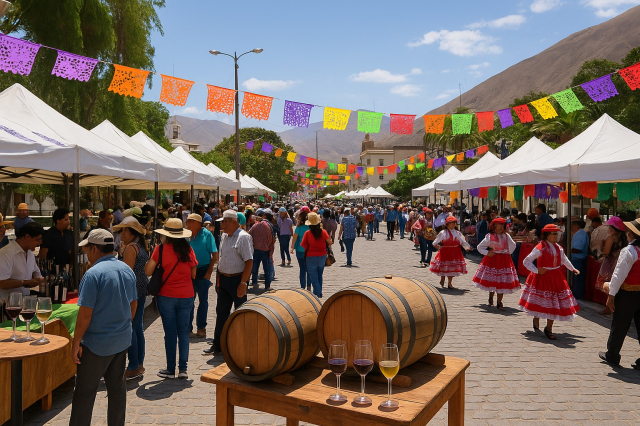Every November, the city of Moquegua is filled with joy, music, and the aroma of grapes. The Wine and Mistela Festival is one of the most representative celebrations in southern Peru, where local producers, tourists, and families gather to pay tribute to the winemaking tradition that distinguishes this region.
This festival is not only a showcase of Moquegua's cultural richness, but also an excellent opportunity to promote domestic tourism and enjoy local cuisine, traditional dances, and, of course, the country's finest artisanal mistelas.
Origin and history of the Wine and Mistela Festival
Moquegua's winemaking tradition dates back centuries. Since colonial times, the Moquegua valleys have been known for their production of excellent quality grapes. Over time, the region has established itself as one of Peru's leading producers of wine and pisco.
The Wine and Mistela Festival was born to revalue this legacy. Held every November , as part of Moquegua's anniversary, it includes tasting competitions, food fairs, parades, and the election of the Mistela Queen .
If you're interested in regional festivals, you can also read about Peru's most important patron saint festivals on our blog.
Main activities of the festival
For a week, Moquegua transforms into a festive setting. Among the most anticipated activities of the Wine and Mistela Festival are:
Wine Fair: where local producers showcase their finest wines, piscos, and mistelas.
Tasting competitions: prizes are awarded to the best artisanal wine and the tastiest mistela.
Parades and traditional dances: Moquegua neighborhoods feature groups in colorful costumes.
Gastronomic tasting: dishes such as spicy guinea pig, moqueguano, and shrimp are paired with local wine.
Concerts and serenades: local and national artists fill the nights of celebration with music.
Mistela: the sweet treasure of Moquegua
Moquegua mistela is a drink that combines wine, aguardiente, and fruits or natural essences. Its sweet flavor and intense aroma make it the symbol of the festival. Each family keeps its own recipe and preparation secret, giving rise to a wide variety of flavors.
Furthermore, mistela has become an export product and a typical souvenir that tourists are eager to take home.
You can also read about other traditional drinks in our article Typical Peruvian Drinks and Their History .
Tourism and attractions of Moquegua
Visiting Moquegua during the festival is a complete experience. In addition to participating in the celebrations, tourists can visit iconic sites such as:
The Plaza de Armas of Moquegua , with its colonial fountain designed by Eiffel.
The Cristo Blanco viewpoint , from where you can see the entire city.
The Contisuyo Museum , which houses archaeological pieces from pre-Hispanic cultures.
The wine cellars , where renowned wines and piscos are produced.
These attractions make Moquegua an ideal destination for those seeking culture, history, and good food.
Economic and cultural impact of the festival
The Wine and Mistela Festival not only boosts tourism but also the local economy. Hundreds of entrepreneurs, artisans, and producers benefit from the event, which attracts more national and international visitors each year.
The Moquegua identity grows stronger with each edition, and new generations learn the value of preserving their customs. Therefore, this festival has become a symbol of regional pride .
Tips to enjoy the festival
If you plan to attend the Wine and Mistela Festival, keep these tips in mind:
Book accommodation in advance, as the city receives many visitors.
Try different types of mistela, each winery has a unique flavor.
Participate in contests and parades to get the full experience.
Take the opportunity to explore the surrounding area: Ilo, Omate and Samegua are very close.
An encounter with the flavor and tradition of Peru
The Moquegua Wine and Mistela Festival is much more than a celebration: it's a living expression of identity, pride, and culture. Participating in it connects with the essence of southern Peru, where wine and mistela tell stories that are shared with every glass.
